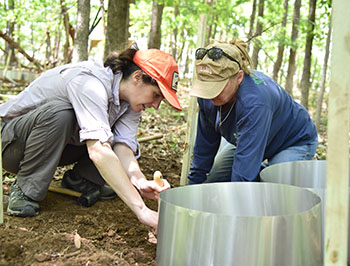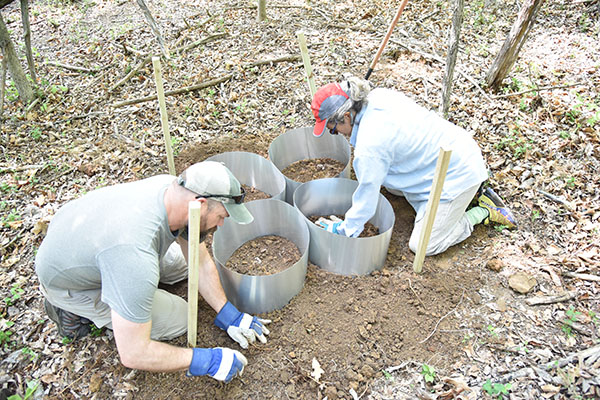In the fight to stop the spread of Lyme disease in the United States, one crucial question has baffled scientists: Why is the disease so prevalent in the northeastern U.S., but in the southeast, relatively few cases have been reported? The trend persists even though the blacklegged ticks (also called deer ticks) that transmit Lyme through their bites can be found throughout the eastern part of the country.
Assistant Professor of Biology and Environmental Studies/Environmental Science Liz Gleim, who is also a tick biologist, says one hypothesis has recently gained traction: the possibility that “the northern and southern populations of the blacklegged tick are genetically distinct, and that difference manifests itself in terms of how ticks quest for a host. A questing tick is one that’s crawling up on the tips of vegetation and hoping a human or animal host is going to brush up against them and they can hop a ride.”
Northern ticks have been found to be far more aggressive when questing and thus more likely to get on people than southern ticks, who tend to live in leaf litter where humans are less prone to come in contact with them.
Even within Virginia, Gleim notes that ticks from the coastal, central, and southwestern parts of the state exhibit different questing behaviors from one another. This phenomenon is the basis for a project this summer in which Gleim is collaborating with scientists from Old Dominion University and the University of Richmond to discover what makes ticks tick.
“Ticks along the coast are generally not as aggressive as those here in the Roanoke area. So what we’re doing is collecting ticks locally, around Richmond, and along the Virginia seaboard, sort of an east-west gradient, in the hope that we get populations that may be showing different questing behaviors,” Gleim explains. “Is their behavior actually controlled by genes, or it prompted by three distinctive climates? The hope is that we’ll be able to find out.”

Gleim and her fellow researchers are taking the ticks they gather between Roanoke, Richmond, and the coast, and placing them in what she describes as “tick arenas,” containers that are located in mature hardwood forest areas, the preferred habitat of blacklegged ticks. At Hollins, the tick arenas have been situated in the woods adjacent to the northeastern part of campus.
“It’s a very cool way in which we can take advantage of our beautiful natural forests that are convenient to campus,” Gleim states. “We’re really lucky because the folks who are conducting research in Richmond and on the coast are having to use public lands, so they have to go through the process of working with state and public officials and securing permission.”
Students from Hollins and the University of Richmond will be working with Gleim on the project at the Hollins site. “They’ll be coming out multiple times a week to make observations on the ticks to see what sorts of questing behaviors they are exhibiting.”

Faculty members from the biology and environmental studies/environmental science programs at Hollins assisted Gleim in constructing the tick arenas and addressing a key concern: how to ensure the ticks they’re studying stay in place while keeping out the ticks that already live in the surrounding forest. “We’re putting sterilized leaf litter into the containers so that we’re certain we’re not inadvertently picking up ticks that aren’t part of our research,” Gleim says. “Installing metal flashing and chicken wire will not only help us keep ticks out but also prevent small mammals or wildlife from entering the arenas. The last zone of defense is this sticky material that’s almost like a paste that we use to coat the inside of each area. So, any ticks that try to leave or enter the arenas will get stuck.”
Gleim and her fellow researchers will be placing ticks in the arenas during the last couple of weeks in May. The study will continue through early and mid-July to coincide with when the blacklegged tick is naturally active.
Conducting tick research at Hollins is fitting. As Gleim notes, “Roanoke itself is a major focal point for Lyme disease. If you look at a map of Lyme cases in the U.S., there’s literally this bright red spot on Roanoke. Areas north of here have a seen a lot of it, too, but southward, there isn’t much. One theory is that northern ticks are making their way down through the mountains to the southern region.”
Featured photo: Associate Professor of Biology Morgan Wilson (left) and Professor of Biology Renee Godard work on several of the tick arenas that will facilitate this summer’s study of blacklegged tick behavior and the impact of genetics versus the environment.











